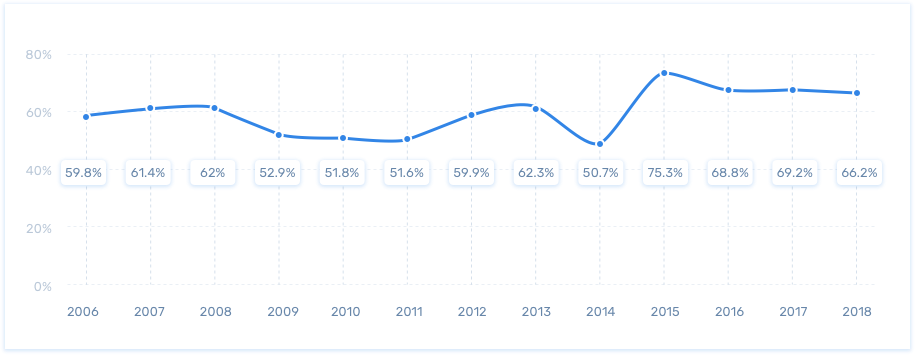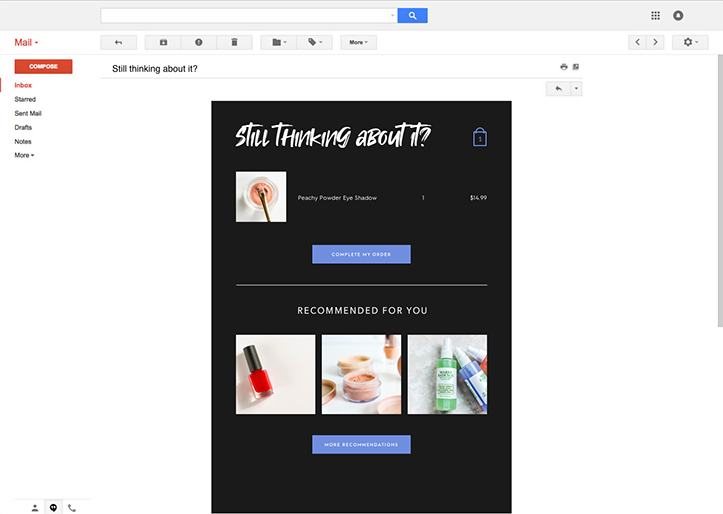How to collect more abandoned cart dollars with personalized emails
If you’re not optimizing your abandoned cart emails, there’s the potential that you’re leaving a lot of money on the table.
The numbers vary a bit, but on average, research has shown that between 65-75% of every item moved to a cart gets abandoned. That can lead to a lot of dollars in lost revenue for brands all across the spectrum.

What’s more, as you can see in the graph above, the numbers are slowly ticking up as e-commerce and online shopping become the primary way to shop for many people.
Those are some pretty staggering numbers. But, if you can lower that percentage by even a few points, the difference in your bottom line can end up being pretty substantial.
That’s what this post is here to help you do. We’re going to show you a few of the best practices out there for optimizing your cart abandonment rate by personalizing emails.
Let’s get to it.
What’s an abandoned cart email?
First, the basics of an abandoned cart email. It’s basically a triggered email that gets sent out when someone visits your site, gets partway through the check-out process but doesn’t complete it.
It looks something like this:

They usually go out anywhere from a few hours to a few days after the triggered activity.
Unfortunately, many brands make these emails look pretty generic. They are a copy and paste type of template with zero personalization beyond the items left in the cart.
If you’re trying to get someone to get re-engaged in the buying process, a standard-issue generic email isn’t exactly going to excite a lot of people.
How to personalize
There are many different reasons why someone will abandon their cart. They range from unexpected costs; maybe the shipping was higher than they thought, to a website crash or timeout.
Regardless of the reason why they didn’t purchase, you want to try to get them back involved as soon as possible. Here are a few ways to do it.
Geolocation
One way to do that is to make sure you send your abandoned cart email based on their time zone, not yours.
Studies have shown that your best chance of getting someone to buy again is if they get their abandoned cart email within 24 hours. But, if you’re using a generic time counter, then you can end up landing in an inbox when someone is sleeping or away from their computer — not great.
Instead, focus on sending these emails very quickly, and based on their time so that you can stay top of mind.
Customer service
Another big reason why many people abandon their carts is that they have some unanswered questions about the products or the process.
Use this as an opportunity to provide that extra level of customer service.
Ask them if there was a problem with the process and let them know you’re ready to help.
Make it easy for them to contact you, right from your email with any questions. You can give a phone number or even a unique link to a chatbox where someone on your customer service team is ready to address their specific problems.
Reward loyalty
It’s not always going to be the case that people who abandon their cart are brand new customers. You’ll likely have plenty of repeat customers doing the same thing too.
If you’re doing a good job tracking and segmenting your email list based on your customer’s behavior, you’ll be able to identify those loyal customers who purchased before but got off track this time.
One way to capitalize on that is to reward their previous loyalty by triggering a special coupon code, discount, or even free shipping offer if they go back into their cart and buy.
If you have a rewards or points system already in place, be sure to feature it in any of your cart abandonment emails, and also highlight how far away they are from the next their too.
Use testimonials
Social proof is a big motivating factor for a lot of people when they are thinking about buying something.
Use that to your advantage in your abandoned cart emails. For every product left in the cart, feature a positive rating, review, or testimonial by a happy customer.
These can help trigger people into feeling that someone who is just like them has bought and enjoyed using your product or service. Today, people trust online reviews almost as much as if they got advice from family or friends.
Always think personalization
When it comes to email marketing, always thinking on the side of personalization is going to take you far. The more ways you can personalize your emails, even these transactional sort of messages, the more likely you are to make additional sales.




